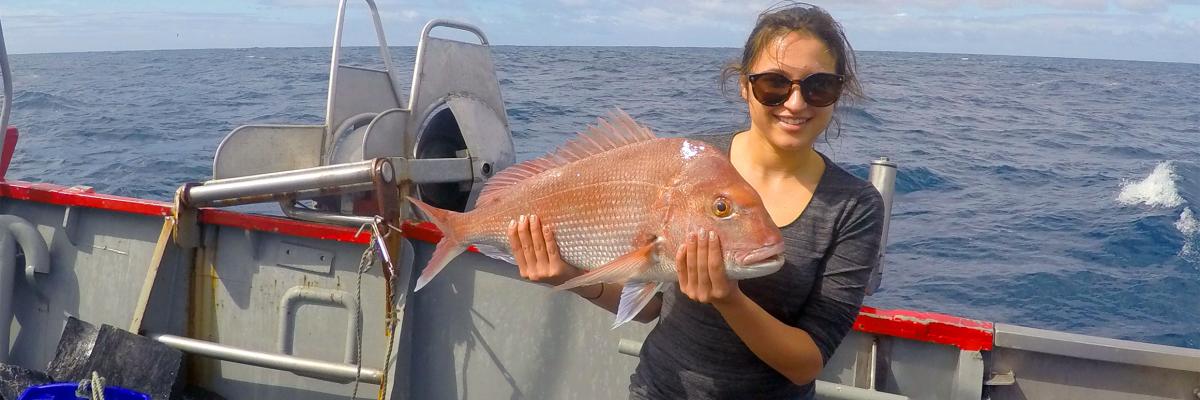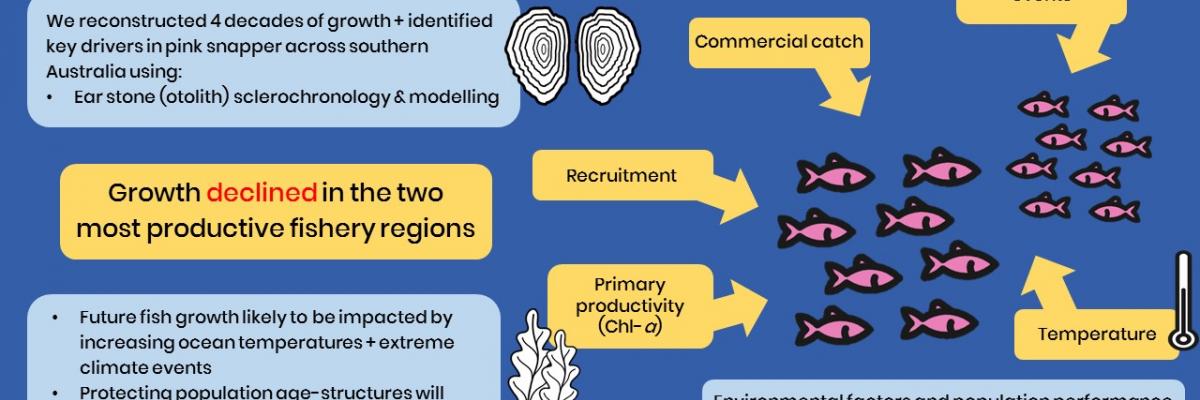Uncovering long-term growth histories in fishery species
Scientists have investigated the use of ear stone (otolith) chronologies to understand long-term trends and drivers of growth in fisheries.

Jasmin Martino is a PhD candidate of fish/fishery biology in the Gillanders Aquatic Ecology Lab .
Growth rates in fish are a fundamental predictor of population size, productivity and mortalities. Faster growth rates increase the size of individual fish which leads to higher biomass, reproductive output, lower natural mortality, and increased success in predator-prey interactions.
Growth in fish is also highly variable and responsive, influenced by not only genetic make-up but environmental selection pressures. As such, growth models are used extensively in fishery management and stock assessments to determine size-related population processes, performance measures and reference points.
The pink snapper
Our study species was the iconic and valuable fishery species, pink snapper (Chrysophrys auratus).
Record catches of snapper were recorded in South Australia in previous decades followed by considerable downturns. Management concerns were then raised about the long-term sustainability and changes to the spatial structure. Growth histories of snapper enhance our understanding of the processes that driver the population and fishery dynamics.
We reconstructed almost four decades (37 years) of growth in snapper across four oceanographically and ecologically diverse regions in southern Australia using otolith sclerochronology and mixed-effects modelling.
Otoliths grow in proportion to the fish size and contain annual rings, like a tree-trunk, that allows for estimates of age and growth of a fish’s entire life. We measured the otoliths of over 500 fish.
Time series of external factors (such as water temperature or commercial catch) were collected to match with the growth profiles. Next, mixed-effects modelling was used to understand both biological, environmental and anthropogenic influences on snapper growth.
Snap! Here are the results
We found that growth rates declined in the two most productive fishery regions. External influences were shown to be significant.
Chlorophyll-a (a measure of primary productivity) was the best predictor of growth but direction and magnitude of effect varied, indicating regional-specific variation in competition. Sea surface temperature positively correlated with fish growth within optimal thermal ranges, but was negatively correlated during extreme climatic events. Contrasting relationships appeared between growth, catch and recruitment suggesting regional-specific density-dependent effects.
Climate change is predicted to increase ocean temperatures by up to 3°C by 2100 and create higher frequency of extreme climate events like El Niño or La Niña episodes. We show that under high temperatures and extreme climate events, fish growth is likely to be impacted.
Simultaneously, large-scale fishing will continue to exert biological and ecological selective pressures worldwide. Particularly, as fishing targets the largest fish, while leaving the smallest, there is natural selection towards slower-growing, smaller fish. Climate change and fishing are predicted to act as cumulative stressors.
We suggest there is a need to bolster resistance against these stressors, potentially by protecting age-structures of wild fish populations. This could be done through management approaches such as expanding marine protected areas (MPA’s) or enacting maximum legal lengths of catch.
Hard-calcified structures like otoliths are a valuable tool for retrospectively unearthing long-term ecological datasets that would otherwise be costly and logistically difficult to obtain through direct methods.
We illustrated their value in determining long-term trends in populations, and both environmental and anthropogenic drivers. Fisheries provide an important food source for the global population and these techniques can inform sustainable fishery practices which will benefit fish populations, the fishing industry and general community.
About the author
Jasmin Martino is a PhD candidate of fish/fishery biology in the Gillanders Aquatic Ecology Lab.

